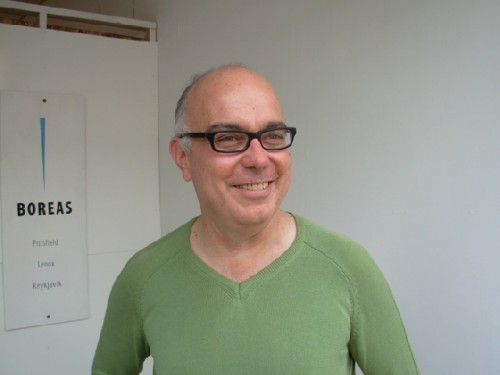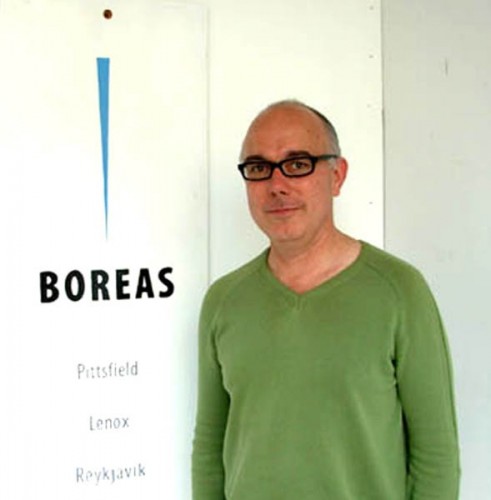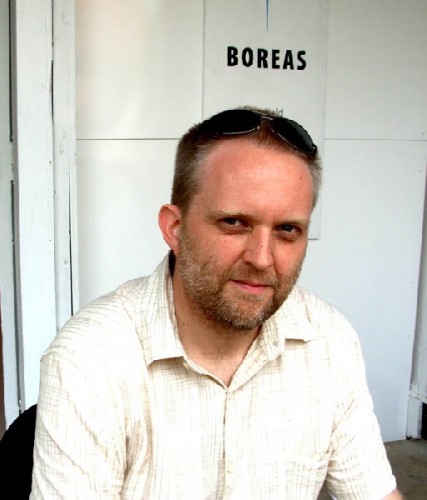Pittsfield: Gallery Boreas
By: Charles Giuliano - Oct 09, 2006
July 6, 2006
Gallery Boreas
What drew us to Pittsfield on a hot, Saturday afternoon was the annual "Open Studios" and the Storefront Artists a group founded by artist, Maggie Mailer, which has attracted national media attention. We hoped to catch up with her but there was a sign that said she would not be present. Walking up and down the main drag, however, Astrid commented that there appeared to be a lot of progress since our last visit. Most notable a new upscale restaurant Spice that we plan to visit and the renovations of the Colonial Theatre which is scheduled to reopen with ambitious year-round programming by the end of the summer.
It was encouraging to see Gallery Boreas back in yet another summer long temporary space. It was precisely the availability of long vacant retail space that first attracted the Storefront project and Boreas to pick up a cheap rental for its experimental programming.
A couple of summers ago we met Scott Laugenour and have been e mail correspondents ever since. I asked him about the long, narrow, vertical triangle in the gallery logo. "Do you know who Boreas is," he asked? I fudged something about Aurora Borealis. But more precisely Boreas was
one of the fours sons of EOS and ASTRAEUS. He's a bluff hearty god who's always willing to blow favor to his fans. Not in the least chilly. Apart from temperature-wise, of course. Married to OREITHYIA, his daughter is CHIONE, the Goddess of Snow, and his sons are the BOREADS.
Hey, who knew? Always good to pick up on a bit of mythology. But why this North Wind as a name and logo for the gallery? Why not Laugenour Gallery? Or Gallery Scott? Guess there is something compellingly Nordic in his character and taste in art. Several years ago, before he opened his gallery in Williamsburg, he traveled to and fell in love with Iceland. Where be bought a small apartment which he visits several times each year and really enjoys all of the seasons from the perpetual sun of summer to the cold and gloom of winter. Most compellingly it is "Just a four and a half hour flight from New York and a great chance to get away." This has led to becoming involved with Icelandic artists and initiating projects to show their work both in Iceland as well as in Brooklyn and the Berkshires. In addition to the apartment in Reykjavik he also owns a house in Lenox and is in the process of renovating the garage as a space to present video art, a particular passion and specialty of the gallery. He has presented and sold video art in the DIVA Art Fair.
None of this is really adding up to making a killing in the "booming art market" as it is touted in the media. Instead he says somewhat whimsically that "The rich get richer and the poor get poorer." The Williamsburg art gallery scene has cooled off. Not that it was ever that hot. "Even when I got great reviews in ArtNet and NYArtsmagazine and other art press that didn't translate into getting collectors to come over the bridge and visit the gallery." When the lease expired recently with a 25% increase, like others in Williamsburg, he decided not to renew. The lights in the new space at 439 North Street in Pittsfield came from Brooklyn.
Would he consider moving to a space in Chelsea? Not really was the answer. "Gallerists in the upper floors in Chelsea are saying the same thing that gallerists in Brooklyn were complaining about, how difficult it is to generate traffic and sales," he said. For now, his strategy includes the summer gallery in Pittsfield, a video salon (by invitation calling Scott at 917 743 6548) in Lenox, a selection of art fairs, and projects in Reykjavik.
The two part program this summer "Portraits On the Edge" is strikingly tough and ambitious. Particularly in a community that caters to tourism. The current show, through July, featuring the Icelandic artist Birgir Snaebjorn Birgission, would be a tough sell anywhere, let alone in downtown Pittsfield. One wall of the gallery includes several, large, closely hung, whited out portraits of young Aryans. It takes some effort and concentration to visually focus on and clarify the closely valued images.
Scott, with typical passion and courage, discussed how he became riveted by the images when he viewed them in a museum exhibition featuring emerging Icelandic artists. Several canvases were rolled up into a tube that he checked as carry on luggage in the return flight to NY. I asked about getting such work into the US without a hassle from customs. "In New York they are pretty used to this and understand that it is art and good to encourage this activity," he said. But he did discuss efforts to import a sculpture from Germany being hung up in a warehouse until two weeks after the opening. A couple of weeks ago Birgir arrived with a bundle of sticks that are the stretcher bars. He is residing and working in the Berkshires for the duration of the exhibition. On August 3 part two of "Portraits on the Edge" opens with the artists Hugo Bastidas, Andrea Hersh, and Eileen Weitzman (through September 3). At the video space, 205 Housatonic Street, Lenox there will be salons on July 13 featuring works by Gudrun Kristjansdottir and on July 20, David Pierce.
How do you sell video art? Scott replied that yes, he does makes sales of video which is often produced in small editions of say just five copies of a DVD. "To make the point I have collected some videos and in my home in Lenox I have a flat screen monitor hanging on the wall like a painting which I use to view some of my favorite pieces." he said. Think of it as a moving painting.
The artist came by and Astrid became intrigued through a discussion of the origin and inspiration of the portraits. There was a photo copy of the 1927 book "Deutsche Kopfe Nordischer Rasse." It contained a series of "ideal" photographs of Germans which had been selected from a great many submissions. The people depicted represent both "pure" and "mixed" people. The artist found the rare book and was inspired by its notions of racial perfection and beauty. Of course the book has racial overtones and suggests the views of a Nazi author. But the book actually predates the rise of National Socialism (1933) and is more racial than racist.
Astrid asked Birgir if he could read the text in its old German typography. The somewhat mixed response prompted her to volunteer to read the relatively short text to the artist who displayed limited knowledge of German. So she offered a running commentary in English. The two hunkered down and became much absorbed in the translation process. She later discussed the books and its insights with me. On many levels, clearly, she got a lot more out of the work than I did. But it was wonderful to share the experience and insights.
Most of all I admire Scott and his originality. As is often the case art is so much more than a business. Yes, it would be nice to make a living. We all want that. But there are many other reasons why we spend our lives in the arts. Most of all he conveys the passion and enthusiasm of living with and presenting the work that he truly believes in. A god of the North Wind indeed; Boreas but never boring.
----





